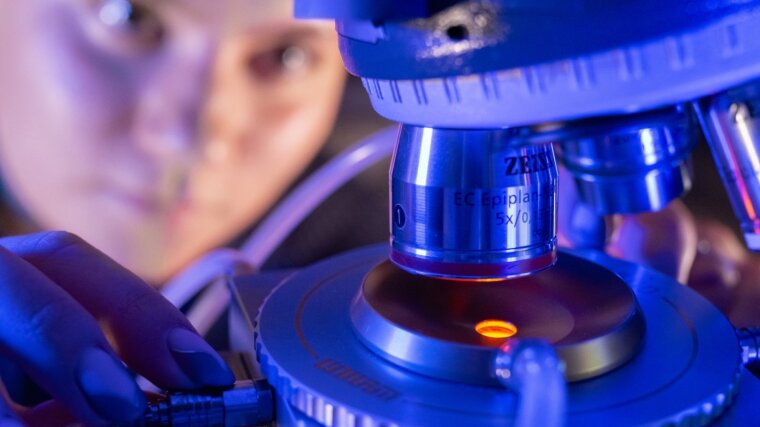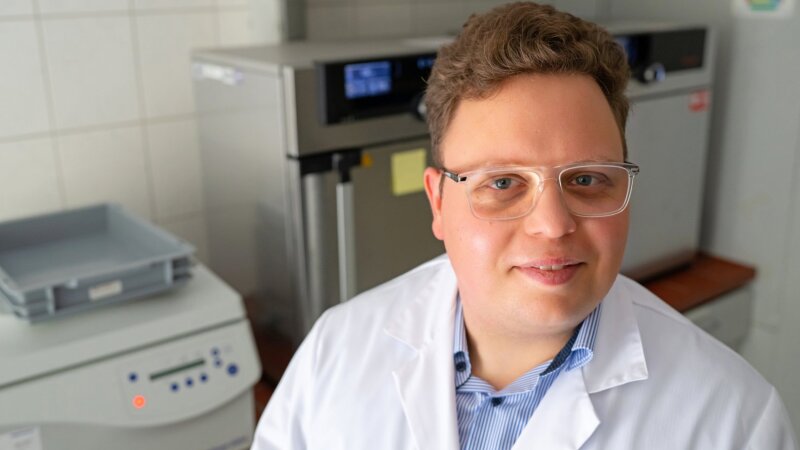
If the greenhouse gas carbon dioxide (CO2) could simply be filtered out of the atmosphere, humankind would have one less major problem. A small step in this direction has now been taken by a research group at the University of Jena: The team from the Otto Schott Institute for Materials Research has developed a glass material that can precisely separate gases from one another.
By Marco Körner
Separating carbon dioxide molecules from gas mixtures requires materials with extremely fine pores. Researchers from Friedrich Schiller University Jena, in cooperation with the University of Leipzig and the University of Vienna, have now found a possibility for such a »molecular sieve«. They transformed crystalline metal-organic framework compounds, so-called zeolitic imidazolate frameworks, into glass.
The team led by Dr Alexander Knebel from the Otto Schott Institute at the University of Jena succeeded in reducing the size of the pores of the material in such a way that they were impermeable to certain gas molecules. The researchers report their findings in the journal »Nature Materials«.
»Actually, these glass-like materials were previously considered non-porous,« explains Knebel. »The starting material, i.e. the crystalline framework compounds, have very clearly defined pores and also a large internal surface area. Hence, they are also researched as materials for storing or separating gases. However, this defined structure is lost during melting and compression. And we took advantage of that.«
»Metal-organic framework compounds consist of metal ions linked together by rigid organic molecules,« describes the leader of the junior research group, explaining the material.
Compressed metal-organic frameworks
»In the spaces of these three-dimensional, regular grids, gas molecules can move easily. During the glass processing, we compressed the material. Put simply, we were able to squeeze the pores down to the desired size,« he illustrates.
Even though the overall structure of the crystal disappears during melting—parts of the crystal retain their structure. »In technical terms, this means: during the transition from crystal to glass, the long-range order of the material is lost, but the short-range order is preserved,« explains Knebel.
Oksana Smirnova, a doctoral student at the University of Jena and the lead author of the work, adds: »When we now melt and compress this material, the porous interstices also change.« As a result, channels with constrictions—or even dead ends—are created, and consequently, some gases simply no longer fit through.
Pore size is a thousand times smaller than the thickness of a human hair
In this way, the group achieved pore diameters of 0.27 to 0.32 nanometres in the material, with an accuracy of one hundredth of a nanometre. »For illustration: This is about ten thousand times thinner than a human hair and a hundred times thinner than a DNA double helix. With this pore size, we were able to separate, for example, carbon dioxide from ethane,« explains Knebel. »Our breakthrough in the field is probably the high quality of the glasses and the precise adjustability of the pore channels,« Knebel categorizes the work. The additional fact that the glasses are several centimetres in size also demonstrates the scalability of the new materials, he says.
According to the researchers, one aim of their work is to develop a glass membrane for environmental applications. After all, separating carbon dioxide from gases is undoubtedly one of the great technological challenges of our time.
Dr Alexander Knebel heads a junior research group at the Chair of Glass Chemistry that is developing new hybrid glasses for gas separation.
Image: Jens Meyer (University of Jena)Original publication:
Precise control over gas transporting channels, Nature Materials (2023), https://doi.org/10.1038/s41563-023-01738-3External link
